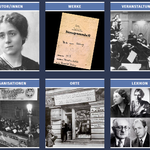History by the Foot: Processing Archival Collections at the LBI




- Author
- Annedore Wilmes
- Date
- Tue, Nov 22, 2016
The suitcase exhales a puff of dust as Frank Mecklenburg sets it down on the floor of his office at the LBI. It is clear that this luggage has reached the end of an extraordinary journey. Faded stickers featuring a long-obsolete American Airlines logo and a 19th-century Dutch resort called the “Grand Hotel & Kurhaus Huister Duin” still cling to the battered leather. Contained inside is the latest donation of archival materials to the LBI.
“Robin Hirsch gave us these two suitcases, which belonged to his parents,” explains Mecklenburg, the LBI’s research director. “They contain photos, documents, and the private correspondence of his parents, spanning from about 1900 until the 1970s.” During the National Socialist regime, Herbert Hirsch and Käthe Lewald fled Berlin for London, where Robin was born in 1942. At the LBI, their suitcases will be unpacked for the last time, and the contents sorted and preserved.
It is not unusual for suitcases, banker’s boxes, and even plastic bags containing historical material to be opened for the first time in decades at the LBI. Today, that job falls to Sophia Stolf. Enrolled in a Masters program in Social and Cultural Studies in Berlin, she is completing a three-month internship in the LBI archives in New York. She carefully opens the dull metal latches and opens the lid to reveal a mound of papers: letters, ID cards, photographs. Some are bound together with strings or wrapped in bags, but many are loose.
“The materials we deal with here are usually handed down within families,” says Hermann Teifer, head archivist at the LBI. Typically, the donors are from the second generation born after the war. From their parents, who belonged to the first post-war generation, they receive the materials that their grandparents saved as refugees from Germany. Thus, the material is often decades-removed from the people to whom it had the most meaning.
“When descendants receive a family collection like this, it is often just a small part of a larger estate,” says Teifer. Dealing with the administration of a parent’s or grandparent’s estate can demand a lot of attention, which means that historical materials sometimes get overlooked. “That is why the materials we receive have often languished in attics or storage spaces for years,” explains Teifer.
Sophia Stolf is making up for lost time. First, she removes all the material and organizes it in acid-free folders, which she places in blue archival storage boxes. To the extent possible, Stolf maintains the exact arrangement and order that the materials were in when the donor handed them over.
Once the materials are in boxes, Teifer assigns a call number, which begins with AR and ends in a serial number. With the call number assigned, the boxes can be added to the computerized catalog as a new donation.
The boxes next make their way to the desk of archivist Dianne Ritchey for detailed processing. Ritchey examines each document, noting its format, purpose, contents, and historical significance. She refines the organization of the material and gives the folders precise titles that describe the contents. Materials without an original order, like the loose sheets in the Hirsch suitcases, are organized into categories (called “series”) that may be defined by genre (e.g., vital documents, photographs, or correspondence), people (e.g., individual authors or correspondents), subject, or chronology.
Ritchey assembles the information about the contents of each box and its folders into a document known as a Finding Aid. The LBI uses a standard for electronic finding aids developed and maintained by the Library of Congress called “Encoded Archival Description” (EAD). The main component of this document is a list of all the boxes, their folders, and the titles of each folder, but it often also includes historical and biographical notes about the people, places, or organizations described in it.
Even before the era of digitization, the Finding Aid served as the main entry point for a collection. Unlike boxes of dusty letters and photographs, it can be searched by computers, allowing researchers to request the specific boxes or folders that they think might contain the answers to their questions.
Since 2007, however, nearly all LBI’s archival collections have been digitized, which makes them much more accessible while sparing the originals from frequent handling. Although most of the collections were digitized by external partners, including the non-profit Internet Archive (www.archive.org), much digitization now occurs in the state of-the-art Gruss Lipper Digital Laboratory at the Center for Jewish History (CJH), just a few floors below the LBI’s offices.
There, Grigoriy Ratinov creates microfilm copies and digital scans of each page. The microfilms are for long-term preservation; microfilm is known to last at least 100 years under the right conditions, while digital files require constant maintenance of servers and safeguards against obsolescence of file formats. The digital files are nevertheless essential to provide access to researchers worldwide. Ratinov provides high-resolution JPEG2000 files to the archivists at the LBI, who upload them into the CJH’s digital asset management system and add links to the Finding Aid that connect each folder title to the images of its contents.
Each donor receives a gift acknowledgement letter that states the value of the collection (in most cases, $500 per linear foot of archival boxes in the processed collection). A gift agreement spells out the transfer of possession and the rights of the donor and the LBI. “Occasionally we discover sensitive documents in the course of processing material that donors have entrusted to us,” says Frank Mecklenburg. “In such cases, we contact the donors to see whether they still want the material made public.”
The LBI seeks to preserve a comprehensive picture of everyday Jewish life in German-speaking countries. According to Mecklenburg, new materials still emerge on a weekly basis that can fill in gaps in this picture. Private owners don’t always recognize the value of the materials, but to archivists, and the thousands of researchers that use the materials every year, it is as clear as day.





